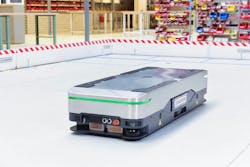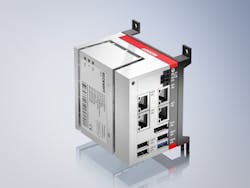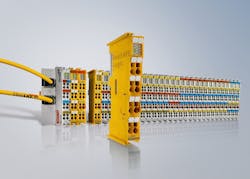Oceaneering Mobile Robotics (OMR), a Houston, Texas-based provider of engineered products and services that focuses on applying mobile robotics to material handling applications, has deployed more than 1700 mobile robots across North America, Europe, Australia and Asia.
“Like many mobile robotics suppliers, we originally focused on bespoke solutions,” says Dr. Gareth Jones, manager of technology for OMR. “But demand has grown across all industries, and we want to increase access to mobile robots. Now, instead of making a few dozen custom vehicles per year, we are focusing on producing hundreds of standardized products, such as the recently released the UniMover O 600.”
The UniMover O 600 is an underride mobile robot for light industrial applications with extremely tight space requirements. It can reach speeds of 1.8 meters per second and handle heavy payloads up to 600 kilograms (1,322 pounds).
Jones says the UniMover O 600 is designed as an effective transportation solution for picking up or dropping off goods or materials, such as raw materials. The vehicle features omnidirectional motion and uses natural feature navigation with safety lidar to recognize and move safely through busy, unstructured environments.
According to OMR, the UniMover O 600 can operate in an autonomous mobile robot (AMR) mode, which provides optimal object avoidance while limiting speed, or AGV (automated guided vehicle) mode, which increases speed but essentially stops when objects are detected rather than maneuvering around them.
Designing the UniMover O 600
To achieve their vision for the UniMover O 600, OMR engineers needed to fit all control hardware into the vehicle’s compact dimensions of 1,670 x 600 x 335 millimeters (65.8 x 23.6 x 13.2 inches). They also had to develop manufacturing processes that would scale to support volume production of the standard solutions.
In the past, they would program the vehicles and manufacturing equipment using Linux, with technicians testing products via Linux line command, says Jones. Though OMR realized the inefficiencies of this process, the engineering team could not afford to completely scrap years’ worth of development.
Each UniMover O 600 vehicle relies on a Beckhoff C6017 ultra-compact industrial PC (IPC) for control logic and other functionality. While Windows has long been the default for Beckhoff machine controllers, the C6017 on the UniMover uses the TwinCAT/BSD alternative operating system (OS). TwinCAT/BSD offers the performance and security of a modern Unix-like OS. As such, it functions like today’s PLCs, which use a real-time operating system (RTOS) rather than proprietary firmware.
“Unlike the ‘black box’ approach of traditional hardware PLCs, TwinCAT/BSD harnesses decades of sophisticated controls development at Beckhoff,” says Doug Schuchart, global material handling and intralogistics manager at Beckhoff. “The powerful OS also remains open, allowing machines to run third-party software, such as Linux distributions, and it enables virtual machines in our new Hypervisor. Many applications benefit from the execution of third-party software alongside the PLC in the same hardware, either in the native OS or another OS in a virtual machine. AGVs, however, gain unique advantages using this architecture.”
The compact form factor of the C6017 reduced space requirements by 56% compared to OMR’s previous machine controller. The C6017 and EtherCAT Terminals also saved OMR engineering time, as OMR technicians can now make standard control kits ahead of time and install them in one enclosure on the UniMover, speeding up commissioning times.
“Our team is very happy with TwinCAT because they can build user interfaces, for example, for performing functional checks in a production line,” says Jones. “This is much more intuitive than using command line in Linux. Plus, they can connect them to data coming off all the peripherals for greater visibility.”
Mobile robot safety
The EtherCAT industrial Ethernet system offers real-time communication, along with free selection of topology and communication to all open protocols. OMR uses the EL6581 DMX master to control safety lights on the vehicle, and the EL6751 CANopen master streamlines communication with a third-party navigation controller. These modules also offer the compact, modular form factor of standard I/O cards.
Because safety is critical for any autonomous robot, and TwinSAFE technology relies on Fail Safe over EtherCAT (FSoE), an international open standard, to enable high levels of safety. FSoE uses a “black channel” approach to communicate safety data over the standard EtherCAT network. This reduces cabling requirements, while providing the necessary redundancy for digital and analog safety.
“With the omnidirectional drive, we have to control two drive motors and two steering motors, so we need to know the positions of the steer angles and the actual speeds of the drive motors themselves,” Jones says. “The enhanced capabilities in TwinSAFE give us more options in the future as well, which will allow us to make even more sophisticated mobile robots.”
Future plans
Based on the UniMover O 600 project’s success, OMR plans to move ahead with Beckhoff technologies in new vehicle systems, such as OMR’s MaxMover CB D 2000 counterbalance forklift.
“The MaxMover replaces conventional forklifts, but even when fully loaded—with payloads over 4 tons—it can also operate in the AGV or AMR modes like the UniMover,” Jones says.





